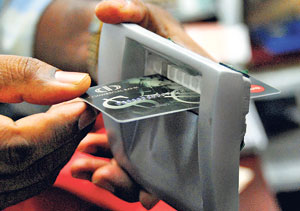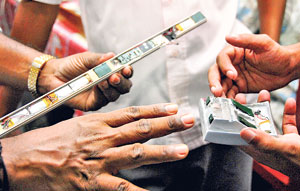| In the first week of December, a leading private bank received complaints from three clients that money from their accounts had been withdrawn without their knowledge.
The bank manager found out that around Rs 300,000 had been withdrawn from the three accounts and the place of withdrawal was traced to Italy.
As an immediate measure, the bank blocked ATM transactions in Italy on its credit or debit cards.
Meanwhile, by December 22, a state bank had received complaints from six account holders. They had said they saw a sudden drop in their balance. The withdrawals were traced to ATM machines in Wellawatta, Dehiwala and Nugegoda. The bank’s security officials replayed the recordings of the Closed Circuit Television (CCTV) cameras installed at ATM outlets in a bid to identify or zero in on any suspects. But they were unsuccessful.
 |
| The gadget the suspects had fixed on to the teller machine |
 |
 |
| Police examine the card slot gadget and the aluminium bar which carried the micro camera. Pix by Sanka Vidanagama |
The two banks discussed the matter and decided to make a complaint to the police on December 24. By this time the amount fraudulently obtained from the private bank’s ATM machines had risen to Rs. 10 million and from the state bank Rs. 4 million, prompting the Criminal Investigations Department (CID) to step in.
The CID studied the transaction details stored in the ATM machines and detected a pattern in the withdrawals. Detectives found that the culprits had visited the ATMs located in every main city between Colombo and Galle around midnight. The time provided a valuable clue.
CID detectives replayed the CCTV recordings of the particular time and the date and closely studied the behaviour of the people seen on the video to pick their suspect or suspects. “We zeroed in on a foreign couple and a local man after watching the recorded tapes of the CCTV cameras,” a CID officer involved in the investigations told the Sunday Times.
But more incriminating evidence was found when the detectives watched the full recording of the CCTV videos. This included day-time recordings. “Daytime recordings show the suspects using a tape and taking the measurements of ATMs and then fixing two gadgets on the ATM’s card inserting slot and the top bar. The Sri Lankan-looking man wore a cap, which made it difficult for the police to get a picture of his face.
“The foreign couple returned in the night and were seen removing the gadgets while the local man was seen arriving a little while later to steal money from the ATM,” the detective said.
Noticing that the suspects had a liking for ATM booths in busy areas, the CID deployed detectives around ATM booths located in towns from Colombo to Galle. The detectives in disguise visited the ATM booths and waited in the vicinity throughout the day.
Meanwhile, the two banks were advised to install extra cameras at the ATM booths which were now under CID watch. These cameras captured customers queuing up to enter the ATM booths and the happenings on the road.
The CID drew a blank on the first day, but the second day proved productive. Security cameras installed at an Ambalangoda branch of one of the banks showed a suspicious-looking Sri Lankan man parking his jeep in front of the ATM booth and entering it. The time was around midnight. The cameras captured the licence number plate of the jeep.
The jeep’s registration details led detectives to an address in Kadawatha. The jeep’s owner told detectives that he had given his vehicle to a person for a monthly rent of Rs. 35,000. The detectives obtained the man’s mobile phone number and tried to trace his address. With the cooperation of the mobile phone service provider, the detectives were able to locate the area from where the suspect was using his phone.
The night after the detectives got the Ambalangoda clue, the CID team monitoring activities at a Galle ATM booth through tele-screens in a security room of the bank saw a man checking the balance of an account but not withdrawing any money. It was around midnight. Making a note of the exact time, the detectives examined the transaction details from the ATM and found out that the card inserted belonged to a woman in Godakanda, a few miles away from Galle town.
The address struck a chord because it was the very address that the detectives who were following the Ambalangoda clue had zeroed in on.
From the CCTV recording, the detectives obtained a clearer picture of the suspect without the cap. They went to Godakanda and discreetly made inquiries about the man. Villagers confirmed that the man in the picture was from the area and told them that he drove a jeep and visited the house in the night occasionally to see his mother.
Detectives in disguise roamed the village for two days hoping that the suspect would visit his house. But they had no success. The third day’s vigil proved successful. The mobile phone service provider, which was monitoring the GPS signals, alerted the detectives to say that the phone was being used from Godakanda. The detectives then surrounded the house and arrested the suspect – a 22-year-old youth.
He admitted that he was involved in the heist together with a cousin. He said that ten years ago, when he was just 12, he went to Italy with an uncle of his and later found a job in a hotel there. It was at this hotel he and his cousin had met a Romanian couple who were experts in stealing money from ATM machines.
The suspect said he along with his cousin and the Romanian accomplices arrived in Sri Lanka to carry out their heists. The method they used was not novel. Many a criminal in the Western world had used it and many an email has been circulated, warning ATM users to be wary of these unusual gadgets.
The trio would visit ATM booths and fix on to the card-slot a gadget that reads the magnetic field of the card being used. An aluminium bar with a wireless micro camera and memory chip was fixed to the top part of the ATM and the video stored in the chip of the micro camera helped the culprits to know the Personal Identification Number (PIN) of the card user.
The suspects would then send the details of the cards along with the video clipping to Italy for their accomplices there to make fake ATM cards.
When the private bank in Sri Lanka stopped its ATM transactions in Italy, the suspects started withdrawing money from ATMs in Sri Lanka.
The detectives have learnt that the suspects have obtained card details and PINs of around 200 people and sent them to Italy.
The detectives have also learnt that the suspects had visited three of the ATMs more often than the others. Two of them belonged to the private bank.
The suspect has told the detectives that if he only knew that the ATMs recorded all details of the card even if the user wanted to check the balance, he would have been more careful with his planning.
The detectives also arrested the suspect’s cousin. The Romanian couple fled the country on December 2 for Italy. The detectives have alerted the Italian police and Interpol and sent them the couple’s photographs. |




